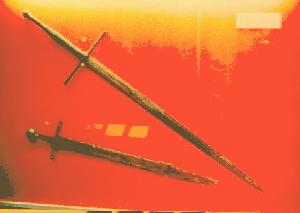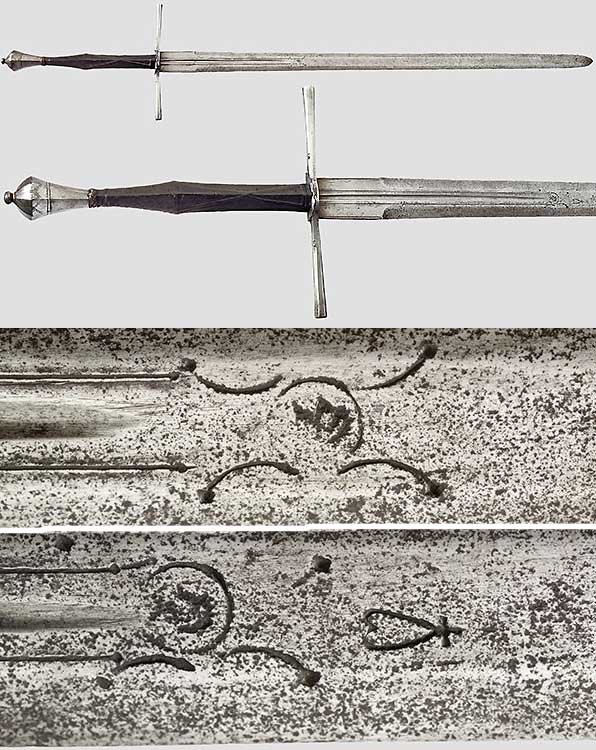| Author |
Message |
Gordon Clark

|
 Posted: Sat 27 May, 2006 6:18 am Post subject: Any historical Type XX pics? Posted: Sat 27 May, 2006 6:18 am Post subject: Any historical Type XX pics? |
 |
|
Does anyone have photos of historic Type XX swords that are better than the ones in Records of the Medieval Sword?
I am particularly interested in XX.3 and XX.4 from Records. Oakeshott says that XX.4 has a blade identical with those in Glasgow and Norwich - and I assume that by Norwich he means XX.3.
I am trying to get a good idea of exactly how the fullering on XX.4 is done - I can see multiple fullers well down the blade, but I may be seeing things.
Gordon
 Attachment: 13.35 KB Attachment: 13.35 KB

|
|
  |
 |
Gordon Clark

|
 Posted: Mon 29 May, 2006 7:48 am Post subject: Posted: Mon 29 May, 2006 7:48 am Post subject: |
 |
|
Ok -if no other pictures are out there, what about opinions on the one above. I can't seem to "see" the "usual" Type XX fullers (one longer central one flanked by two shorter, that are clear in the (single sword pic) one below, for instance. What do you guys think/know?
BTW, I think I might have found a pic of the Norwich sword (longer one in the 2 sword pic), but it is so fuzzy that I can't even be sure.
Gordon
 Attachment: 11.38 KB Attachment: 11.38 KB

 Attachment: 6.92 KB Attachment: 6.92 KB

|
|
  |
 |
Gordon Clark

|
 Posted: Mon 29 May, 2006 7:52 am Post subject: Posted: Mon 29 May, 2006 7:52 am Post subject: |
 |
|
I guess I am not surprised that better pics are hard to find, since Nathan and co probably used the best ones they could get for the Type XX article http://www.myArmoury.com/feature_spotxx.html. Ah well...
Gordon
|
|
  |
 |
Kirk Lee Spencer

|
 Posted: Mon 29 May, 2006 8:04 am Post subject: Posted: Mon 29 May, 2006 8:04 am Post subject: |
 |
|
Hey Gordon...
How about this one from Hermann Historika?
ks
 Attachment: 97 KB Attachment: 97 KB

Two swords
Lit in Eden’s flame
One of iron and one of ink
To place within a bloody hand
One of God or one of man
Our souls to one of
Two eternities
|
|
  |
 |
Gordon Clark

|
 Posted: Mon 29 May, 2006 12:06 pm Post subject: Posted: Mon 29 May, 2006 12:06 pm Post subject: |
 |
|
Kirk,
Almost looks like a cross betwen an XX and an XIX - the rather short side fullers and the decoration looking XIX'ish, but with the typical hilt I associate with an XX. The point is also more spatulate. - Interesting - thanks!
Gordon
|
|
  |
 |
|
Peter Johnsson
Industry Professional
|
 Posted: Mon 29 May, 2006 3:36 pm Post subject: Posted: Mon 29 May, 2006 3:36 pm Post subject: |
 |
|
| Gordon Clark wrote: | Ok -if no other pictures are out there, what about opinions on the one above. I can't seem to "see" the "usual" Type XX fullers (one longer central one flanked by two shorter, that are clear in the (single sword pic) one below, for instance. What do you guys think/know?
BTW, I think I might have found a pic of the Norwich sword (longer one in the 2 sword pic), but it is so fuzzy that I can't even be sure.
Gordon |
Gordon, you are right:
Type XX blades like XX.4 are typically of a lenticular section. The fullers are shallow and cut into the blade so that they stagger from 3 to 2, or from 4 to 3 to 2. It is a bit like the fullers on a Cinquedea, but with a softer, sort of blended effect. The fullers are generally only one millimeter deep or so. Not really doing much in eating away mass. If you draw a line between the high spots of the ridges between the fullers down to the edge belvels you´ll trace a more or less perfect lense shape.
The two type XXa swords that Oakeshott published in his "Records" are really quite different animals. I am at a loss to see what they have in common with type XX swords. XXa.1 is really like a type XVII with a fullered ricasso (thick, stiff and stout). XXa.2 is perhaps rather a XVIIIb (according to "Chivlary" typology) of a convex diamond section with a fullered ricasso added (it is a long, slim and felxible blade: light and nimble). Either of these two blades have very little in common in style, character or function with each other or type XX blades in general.
I have yet to see a type XX sword that has a ricasso. It is exceedingly rare to see a type XX with a single central fuller that reaches from the base to the end of the fullered section, with just two shorter fullers flanking on each side.
Personally I would have loved to see Oakeshott publish other examples of the XXa group. Perhaps that would have illustrated the distinctions more clearly? To me the last types in the typology seem to lack the obvios clarity of the X-XIX groups.
I think this is a result of blades becoming more varied in style towards the end of the 15th C: they do not really take well to being grouped together in a few encompassing groups.
On the XX.4 (and many others like it) the base has three shallow fullers. the central one reaches about three fifths towards the pont. The flanking two fullers continue on to within a few inches from the point, creating a midrib between them. The central fuller blends into this midrib by lifting out of the blade in a slow gradual lift, while the flanking two fullers grow gradually wider to fill the space.
All along the length of the blade the edge bevels are the same as they would on a normal lenticular shaped blade.
This design makes for a small diminishing of weight while leaving most of the stiffness. I cannot but help thinking it was a way for the grinders of the time to show of their skill.
Many second rate blaes of this type reached scandinavia in the late 15th and early 16th C. They were commonly mounted according to local fashion with a peculiar "pretzle" style guard: a large loose knot formed by the long arms of the guard.
|
|
   |
 |
Gordon Clark

|
 Posted: Mon 29 May, 2006 6:45 pm Post subject: Posted: Mon 29 May, 2006 6:45 pm Post subject: |
 |
|
Thanks Peter -
That helps explain a lot! What is the "character" of the XX swords - as opposed to the XX.a ones? I had assumed they were cut and thrust from their points, but a lenticular blade would indicate more "cut" than thrust? I had been imagining something like an XVIII with fullers - would it be more like an XII.a with multiple fullers?
Thanks
Gordon
|
|
  |
 |
|
Peter Johnsson
Industry Professional
|
 Posted: Tue 30 May, 2006 5:33 am Post subject: Posted: Tue 30 May, 2006 5:33 am Post subject: |
 |
|
They are often rather substanital battle weapons with cut and thrust capabilty.
Heavy type XVIIIb´s with lenticular section, perhaps?
If you can imagine such a thing...
|
|
   |
 |
|
|

